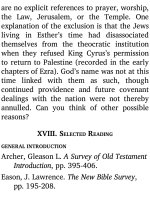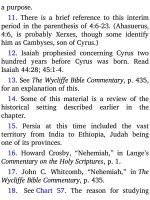Jensens survey of the old testament adam 613
Bạn đang xem bản rút gọn của tài liệu. Xem và tải ngay bản đầy đủ của tài liệu tại đây (152.53 KB, 4 trang )
(e.g., 3:3), then Jude was written after
Peter’s epistles.
16. The word antinomianism comes from
anti-nomos (“against law”), and represents a
libertine spirit that rejects the restrictions of
commandments as such.
17. Quoted by J. H. Kerr, Introduction to the
New Testament, p. 308.
18. See D. Edmond Hiebert, The Non-Pauline
Epistles, pp. 159-64, for a discussion of the
canonicity of Jude.
19. Kenneth S. Wuest, In These Last Days, p.
251.
20. See Charles C. Ryrie, “I, II, III John,” The
Wycliffe Bible Commentary, p. 1489.
21. See S. Maxwell Coder, Jude: The Acts of
the Apostates, pp. 36-43, for a defense of
this view.
22. A highly recommended book for
supplementary study is S. Maxwell Coder,
Jude: The Acts of the Apostates.
Part 4
THE CLIMAX
Christ Triumphant
The book of Revelation is the climax of
God’s Book, the last chapter of world
history. The opening book of Genesis
records the beginnings of the universe and
the human race, and this closing book
prophetically views the coming eternal new
heaven and new earth. In Revelation,
Genesis’s reporting of man’s Fall and
consequent curse sees its ful llment in
divine judgments for sin, which reaches into
eternity.
Truly a study of the Bible is incomplete
without a study of Revelation.
REVELATION
24Apocalypse: The Revelation of Jesus
Christ
The book of Revelation (Apocalypse) is
the written record of dramatic, God-sent
visions given to one of God’s servants. John
says he was “in the Spirit on the Lord’s day”
(1:10) when he heard and saw the things
that he was commanded to write down. A
study of this last book of the Bible can be
one of the most fascinating and aweinspiring experiences you can have.
I. BACKGROUND
This section of the background of
Revelation should be studied carefully as a
solid preparation for surveying the Bible
text.
A. AUTHOR
Four times the author is identi ed by
name as John (1:1, 4, 9; 22:8). Read the
verses and note how John relates himself to
others. Both internal and external witness is
strong in identifying this John as the
beloved apostle, author of the gospel and
the three epistles. It is interesting to note
that John does not name himself in the
gospel or in his epistles, whereas he does so
here. This may be because the very nature of
prophecy calls for identi cation and
credentials of the author.
B. DATE AND DESTINATION
John probably wrote this book around A.D.
96, at the end of the reign of the Roman
emperor Domitian (A.D. 81-96). Domitian
banished John to the Island of Patmos (see
Map Y) because of his Christian stand (Rev.









